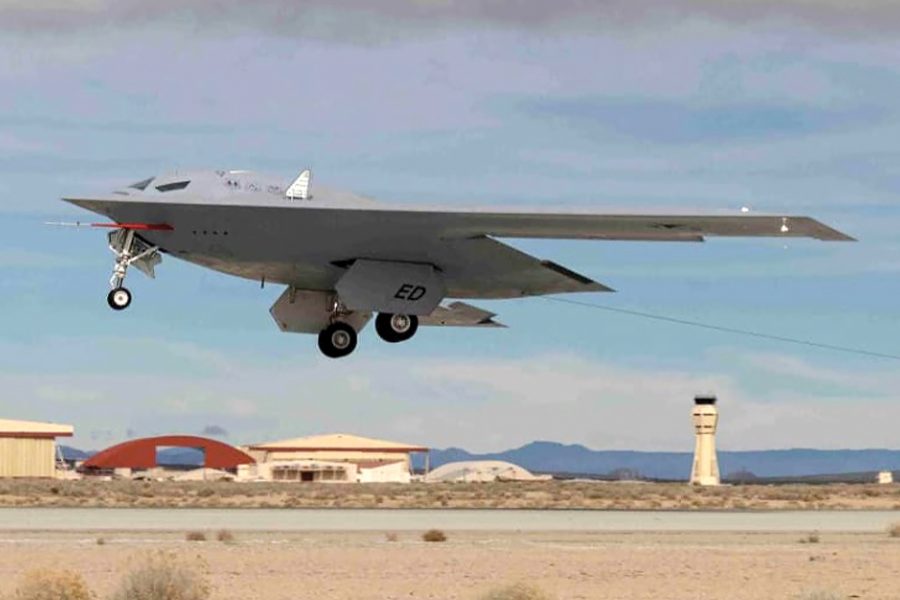Whiteman Air Force Base, Mo.—currently the Air Force’s sole B-2 Spirit bomber base—has been designated the second planned Main Operating Base for the new B-21 Raider, Air Force Global Strike Command confirmed.
The news was first announced by Rep. Mark Alford (R-Mo.) and Sen. Eric Schmitt (R-Mo.) on social media.
Whiteman was designated the “preferred” next B-21 base in an environmental impact statement (EIS) published by the Air Force in May, but the official decision was not confirmed until this week.
Whiteman will join Ellsworth Air Force Base, S.D., as one of the first B-21 operating locations. Ellsworth, designated as the first B-21 base after clearing an environmental impact assessment in 2021, is also intended to be the Formal Training Unit for the new stealth bomber, which entered flight test last fall. Ellsworth, Whiteman, and Dyess Air Force Base, Texas, were announced as the “preferred” beddown locations for the B-21 in 2019. Ellsworth and Dyess currently host the B-1 Lancer bomber.
The announcement means Dyess will almost certainly be designated as the B-21’s third and final Main Operating Base. The Air Force has not given timelines for when the bases will convert from their current aircraft to the B-21.
Whiteman hosts the entire fleet of 19 B-2s. Two others have been lost in crashes, and about 14 are available for action at any given time. The B-1 and B-2 are notionally scheduled to start retiring in 2031 and 2032, as Global Strike Command, which also operates B-52 bombers, has said it will not have the personnel or funding to field all four bomber fleets simultaneously.
The B-52 is receiving a series of upgrades to its engines, radar, and avionics that are expected to extend its service life into the 2050s. The B-52 fleet of 76 airplanes is consolidated at Barksdale Air Force Base, La. and Minot Air Force Base, N.D.
Besides the one aircraft in flight test, the Air Force has acknowledged having five additional B-21s in various levels of production. Northrop Grumman conducts final assembly of the bomber at its Palmdale, Calif. facilities. Recent comments from senior leaders and the Air Force’s fiscal 2025 budget submission suggest the Air Force will buy 100 B-21s at a rate of about seven per year.
Although the Air Force has consistently said the B-21 acquisition objective is “at least 100” of the bombers, Air Force Chief of Staff Gen. David Allvin has suggested the bomber may be overtaken by more advanced technology and that 100 may be the limit.
He told the Senate Armed Services Committee in April that “we’re not going to reach that number [100] until probably the mid-2030s” or beyond, and “before we commit to that as being the platform” that will be the backbone of the future bomber force, “I think there are other technological advancements that we would see to be able to augment that and have a better mix.”
The environmental impact statement the Air Force released in May said that Whiteman would see some minor effects of switching from the B-2 to the B-21.
“There would be an increase of 1,021 individuals at Whiteman AFB from 19,408 to 20,429 after all B-21 mission individuals have arrived and all B-2 mission individuals have departed,” the statement reads. “The number of airfield operations flown per year would increase by 1,980, from 29,771 … to 31,751” by the time all the new aircraft arrived. There would be a need for increased base housing as a result.
“Airfield operations at Whiteman AFB would increase by 6.65 percent from baseline levels,” per the statement. “This minor level of increase would not likely impact airspace use, [Air Traffic Control], or scheduling, therefore no significant impacts are anticipated.”
Whiteman will need “construction of 16 new facilities or facility additions (600,000 square feet), renovation or repair of 26 facilities (1.7 million square feet), and demolition of three facilities (85,000 square feet) … to support the [Main Operating Base 2] mission at Whiteman,” the EIS said.
Thirty-seven percent of on- and nearby off-base residents would be exposed to a higher level of noise—mainly due to an increased number of aircraft—but the highest individual noises would be no greater than what is experienced now, according to the statement.
The EIS said there would be slightly more water runoff due to more concrete, and some wildlife would be displaced by the new construction, particularly of weapon storage facilities. Measures would be taken to mitigate those effects. Overall, the changes at Whiteman were deemed to pose “no significant impacts to wildlife … or critical habitat under the training space.”
As to flight safety, “because the B-21 would be a new aircraft, historical mishap rates are not available; however, current aircraft flight safety policies and procedures are designed to ensure the potential for aircraft mishaps is reduced to the lowest possible level. These safety policies and procedures would continue, and impacts would not be significant.”
The first B-2 arrived at Whiteman in December 1993, on the 100th anniversary of the Wright Brothers’ first powered flight. Only 21 were built; one was lost in a 2008 crash on Guam and another in 2022 at Whiteman.
The Air Force has not disclosed when it plans to declare initial operational capability with the B-21, but the original contract for the aircraft said the program would yield a “usable asset” around the mid-2020s.
